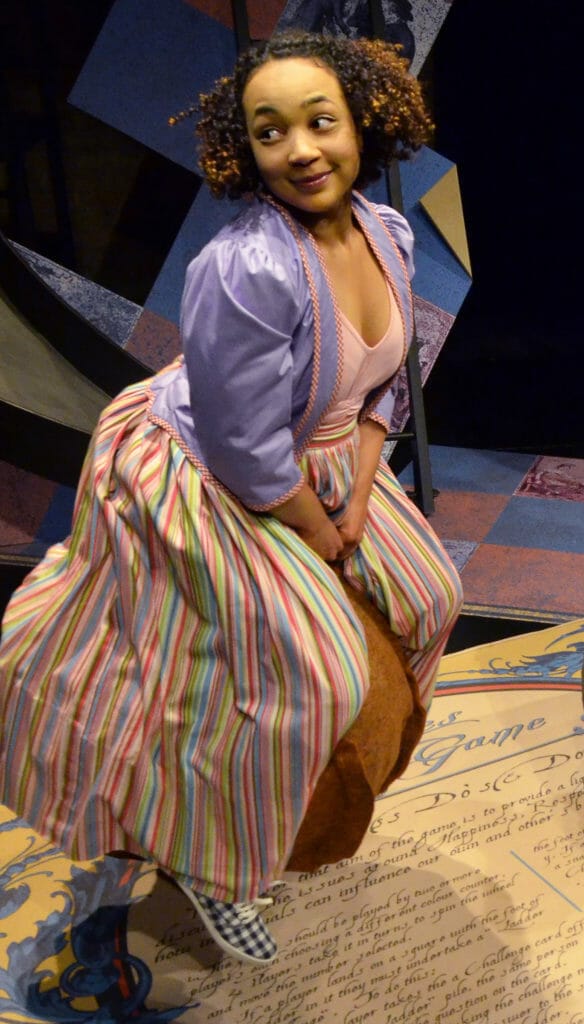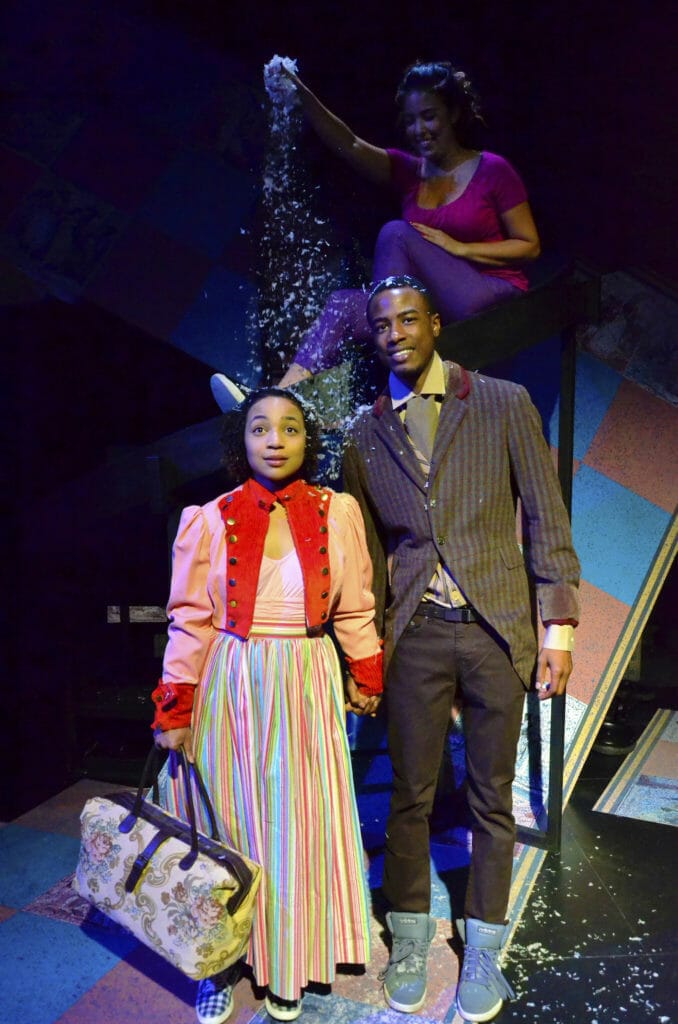Lifeline Adaptation is Stage-Specific
How do you do a Regency romance that takes advantage of the specific possibilities of theatre, as opposed to a reduced film version? Lifeline Theatre ensemble member Christina Calvit has some experience with that problem, having adapted several of Georgette Heyer’s historical novels for the company since 1995. Her latest offering, Sylvester, or The Wicked Uncle, uses the conceit of a game of Snakes and Ladders (better known by its variant, Chutes and Ladders) to represent the social jockeying of its characters and their moral decisions. It’s a source of endless amusement that complements Calvit’s character-driven storyline and provides director Dorothy Milne with a dynamic way of staging action scenes that would be hard to do realistically.
A Scandal Borne Out of Careless Cruelty
A chorus introduces us to our two protagonists: minor noblewoman and secret novelist Phoebe Marlow (Samantha Newcomb) and Sylvester Rayne, the Duke of Salford (Andrés Enriquez). Phoebe made her societal debut the previous season and was received with general indifference, which suits her just fine but enrages her ambitious, wicked step-mother. Sylvester was deeply wounded by the death of his younger brother, whose son he is now the guardian of. He thinks this means he is obliged to take a wife. Phoebe’s grandmother decides it would be a grand idea to set up Phoebe and Sylvester as a match, but Phoebe has no interest in marriage and formed a negative opinion of Sylvester due to his haughty treatment of his servants and his “Satanic eyebrows.” She even wrote him as the villain of her book, which she expects to soon be published to delicious scandal.
Thinking she will be forced into a marriage, Phoebe flees with her loyal groomsman, Thomas Orde (Terry Bell), but their carriage crashes and they wind up dependent on Sylvester for help. This turns out not be a bad thing, and he and Phoebe warm up to each other. However, Phoebe is unable to prevent the novel from being published, which not only humiliates Sylvester, but turns out to strike at him much more personally than Phoebe had meant to. He figures out she’s the author and is furious even before the book inspires his ward’s irresponsible mother and dirtbag new husband to attempt to abduct her son, creating a strong possibility of substantial, lasting harm.
When Lovers are Their Own Greatest Obstacle
True to the characters of Heyer’s inspiration, Jane Austen, Phoebe and Sylvester are likeable enough to start with but have a lot of growing to do. Newcomb’s performance makes Phoebe a wry, introspective, sharp-tongued, and socially awkward anti-heroine while Enriquez’s Sylvester is gentlemanly but a bit insensitive and transparently insincere in his pleasantries. Much of the show’s humor is derived from the spins and cards of the Snakes and Ladders game delivering instant karma and commenting on our leads’ bad behavior. The six-person chorus takes great delight in setting up fraught situations and in stepping in to play all the other characters (except Sylvester’s ward, who nobody wants to play and they foist on each other). We most definitely get the feeling that they want Phoebe and Sylvester to get together, but in a way that makes the game interesting and only after they’ve earned it. They’re good stand-ins for the audience.
Director Dorothy Milne makes Alan Donahue’s scenic design, with all its slides and levels, into an integral part of the story. Besides being a visual aid regarding the characters’ status, it allows variation in blocking during several parts of the story which consist of characters getting to know each other better while stuck due to traveling conditions.
Donahue also designed hilarious props which add to the atmosphere of the game and keep it fanciful. Despite these odd ways of representing the Regency world, Milne keeps the stakes high, and there’s real tension when it seems impossible for Phoebe and Sylvester to reconcile. The play is a whole lot of fun and, though it revels in the genre’s artificiality, it faithfully captures the spirit.
Highly Recommended
Running time is two hours and fifteen minutes with one intermission.
Note: This is now added to the Picture this Post round up of BEST PLAYS IN CHICAGO. Click here to read — Top Picks for Theater in Chicago NOW – Chicago Plays PICTURE THIS POST Loves.
Note: An excerpt of this review appears in Theatre in Chicago.
Where
Lifeline Theatre
6912 N Glenwood Ave, Chicago
When
Thru Oct 29, 2017
Thursdays at 7:30 pm
Fridays at 7:30 pm
Saturdays at 4:00 pm and 8:00 pm
Sundays at 4:00 pm
Tickets
$40
Discounts for military, students, seniors, rush, groups
Call 773-761-4477
Visit LifelineTheatre.com
Photos
Suzanne Plunkett
About the Author: Jacob Davis

Jacob Davis is a freelance writer and dramaturge. He is a graduate of the University of Illinois at Urbana-Champaign’s Department of Theatre, where he specialized in the history of dramatic literature and interned as a dramaturge for Dance Heginbotham. His professional work includes developing new performance pieces such as The Blues Ain’t a Color. Since moving to Chicago in 2014 he has reviewed theatre, written articles, and conducted interviews for a number of websites.




